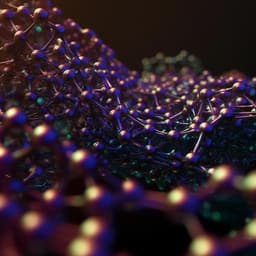
Engineering and Technology
Machine learning assisted discovery of high-efficiency self-healing epoxy coating for corrosion protection
T. Liu, Z. Chen, et al.
This study, conducted by Tong Liu, Zhuoyao Chen, Jingzhi Yang, Lingwei Ma, Arjan Mol, and Dawei Zhang, unveils a groundbreaking machine learning workflow that accurately predicts the corrosion resistance of self-healing epoxy coatings. Through advanced modeling and optimization, the researchers established a formulation that not only exhibits remarkable durability but also showcases excellent self-healing properties, outperforming conventional coatings in rigorous testing.
~3 min • Beginner • English
Introduction
Epoxy (EP) coatings are widely used for corrosion protection due to strong adhesion, high corrosion resistance, and mechanical robustness, but cracks during service degrade performance. Self-healing coatings offer a route to restore barrier properties. Intrinsic self-healing via reversible covalent or noncovalent interactions, especially dynamic hydrogen bonds (e.g., UPy units), enables repeatable repair under mild conditions. As a performance index, the low-frequency impedance modulus from EIS at 0.01 Hz (Z0.01Hz) correlates with corrosion resistance; higher Z0.01Hz indicates better barrier performance. Target indices for ideal self-healing corrosion-protective coatings include Z0.01Hz after repair approaching that of intact coatings, Z0.01Hz > 10^10 Ω·cm2, and long-term stability. Achieving these targets requires optimization across multiple formulation components (resins, curing agents, additives), and traditional trial-and-error is inefficient. Machine learning (ML) can accelerate design, but data scarcity in polymer systems is a challenge. This work applies an ML framework combining active learning and Bayesian optimization to efficiently discover high-performance self-healing EP composite coatings (EP resin + polyetheramines + UPy-D400 hydrogen-bond units + ZIF-8@Ca microfillers) by maximizing lg|Z|0.01Hz of scratched coatings.
Literature Review
The paper reviews self-healing mechanisms in polymers (extrinsic micro/nanocapsule release and intrinsic reversible bonds such as disulfide, Diels–Alder, hydrazone; noncovalent metal–ligand and hydrogen bonding) and emphasizes dynamic hydrogen bonding (UPy) for reversibility and mild repair conditions. Prior EP self-healing using UPy showed rapid repair with high Z0.01Hz after 60 days. In ML for materials, examples include neural networks for viscoelastic behavior prediction, graph neural networks for molecular descriptors, and strategies tailored for small datasets such as active learning, hierarchical ML, and data augmentation (NNI, SMOTE) combined with XGBoost. Active learning has been used for EP adhesive strength prediction and polymer property optimization, motivating its use here for small-sample optimization of self-healing EP coatings.
Methodology
Design of experiments and data acquisition: Four formulation variables were considered: (i) polyetheramine curing agent molecular weight (MW: 230, 400, 2000, 4000 g·mol−1), (ii) molar ratio of polyetheramine to epoxy (r: 0.55, 0.70, 0.85, 1.00), (iii) UPy-D400 content (5, 10, 15, 20 mol%), and (iv) ZIF-8@Ca microfiller content (5.5, 7.0, 8.5, 10.0 wt.%). An orthogonal Latin square design selected 32 representative conditions from the 4^4 = 256 possible combinations. For each, coatings were prepared and the target property measured as lg|Z|0.01Hz of scratched coatings via EIS to reduce variability effects.
Coating preparation: ZIF-8@Ca microfillers were dispersed in E51 epoxy resin under stirring, followed by addition of polyetheramine and UPy-D400 (mechanical agitation at 500 rpm for 10 min). Q235 steel substrates were polished (150/240/400 grit), ethanol-cleaned, and N2-dried. Coatings were applied with a bar coater and cured at room temperature for 48 h to ~85 µm dry film thickness. Through-coating scratches (~3 mm length, ~60 µm width) were made with a scalpel for EIS tests.
EIS measurements: Conducted in 3.5 wt.% NaCl using a CHI-660E workstation with a three-electrode cell (coated steel working electrode, Pt counter, SCE reference). Frequency range 10−2–10^5 Hz; 0.02 V rms perturbation. Each condition was measured at least five times for reproducibility. Z0.01Hz from Bode plots was used for assessing barrier and self-healing performance.
Model selection and validation: Input features were the four variables; output was lg|Z|0.01Hz. Features were standardized (Gaussian: mean 0, variance 1). Five regressors were compared via 10-fold cross-validation: linear regression (LR), artificial neural network (ANN), support vector regression (SVR), decision tree (DT), and random forest (RF). Metrics: R^2, MAPE, and RMSE. RF outperformed others and was selected.
Active learning: Starting from 32 initial samples, the RF model predicted lg|Z|0.01Hz for the 224 untested conditions, ranked them, and proposed top-5 for experimental validation. New measurements were added to retrain the RF model. This propose–measure–retrain cycle was repeated 5 times after an initial proposal set, leading to a total dataset size of 62 samples. Stopping criterion: stabilization of R^2, MAPE, and RMSE improvements.
Bayesian optimization (BO): To refine promising regions, r was varied from 0.85–1.00 (step 0.1), UPy-D400 from 10–20 mol% (step 1), microfiller from 5.5–10.0 wt.% (step 0.1); MW fixed at 400 and 2000 g·mol−1. RF served as the surrogate model; expected improvement (EI) was the acquisition function, run for 1000 iterations using GPyOpt. Top-ranked candidates were synthesized and tested.
Additional validation: Intact and scratched coatings (pure EP and optimal ZIF-8@Ca/EP) were characterized by EIS over time (up to 60 days immersion). Salt spray testing (ASTM B117/D1654) was conducted for 60 days. Adhesion strength was assessed via pull-off tests before and after salt spray exposure.
Data and code: ML implemented in Python with scikit-learn (v1.1.1) and GPyOpt. Code available at https://github.com/lt037870521/manuscript-code-EP-Lt.
Key Findings
- Initial 32-sample dataset: measured lg|Z|0.01Hz values ranged from 4.75 to 10.87 (lg(Ω·cm^2)).
- Model selection: Random Forest outperformed LR, ANN, SVR, and DT on 10-fold CV.
- Active learning performance (final dataset n = 62): R^2 = 0.709, MAPE = 0.081, RMSE = 0.685 (lg(Ω·cm^2)); improvements over initial dataset of 246% (R^2), 51% (MAPE decrease), and 47% (RMSE decrease). New high-performance conditions with measured lg|Z|0.01Hz > 11 were discovered.
- Bayesian optimization (MW fixed at 400 or 2000 g·mol−1; refined r, UPy, filler ranges): Top candidates measured lg|Z|0.01Hz values: 11.58 ± 0.28; 11.15 ± 0.65; 10.98 ± 0.40; 10.90 ± 0.68; 10.85 ± 0.74 (lg(Ω·cm^2)). The highest corresponds to |Z|0.01Hz ≈ (4.40 ± 2.04) × 10^11 Ω·cm^2.
- EIS of intact coatings (30 min immersion, 3.5 wt.% NaCl): Pure EP |Z|0.01Hz ≈ 3.98 × 10^10 Ω·cm^2; optimized ZIF-8@Ca/EP exhibited much higher |Z|0.01Hz with an average (across six samples) of (4.63 ± 2.08) × 10^11 Ω·cm^2.
- EIS of scratched coatings: Optimized ZIF-8@Ca/EP exhibited |Z|0.01Hz ≈ 3.80 × 10^11 Ω·cm^2 initially, decreasing slightly to 1.23 × 10^11 Ω·cm^2 after 60 days immersion, indicating effective self-healing and sustained barrier properties; behavior remained predominantly capacitive over a broad frequency range, similar to intact coatings.
- Salt spray (ASTM B117/D1654, 60 days): Pure EP showed early corrosion and delamination; optimized ZIF-8@Ca/EP displayed only slight trace at 30 days and a single small corrosion spot at 60 days.
- Adhesion (pull-off): Dry adhesion strength—pure EP 4.70 MPa vs ZIF-8@Ca/EP 9.82 MPa. After 60 days salt spray—pure EP 0.97 MPa (79.4% loss) vs ZIF-8@Ca/EP 9.50 MPa (3.3% loss).
Discussion
The study demonstrates that a data-efficient ML workflow can rapidly optimize complex epoxy coating formulations under small-sample constraints. Active learning guided experiments toward high-performing regions, improving model accuracy while discovering compositions exceeding the best in the initial dataset. Bayesian optimization further balanced exploration and exploitation using uncertainty-aware expected improvement, identifying an optimal formulation with exceptionally high lg|Z|0.01Hz. The selected conditions—moderate MW (400–2000 g·mol−1), high r (0.94–1.00), and mid-range UPy-D400 (≈14–20 mol%) and ZIF-8@Ca (≈7.4–8.8 wt.%)—align with mechanistic considerations: higher amine content enhances shape recovery enabling physical closure of scratches; UPy quadruple hydrogen bonds provide intrinsic reversible crosslinks for healing; ZIF-8@Ca microfillers act as barrier enhancers and pH-responsive carriers. Electrochemical and environmental tests confirmed that the optimized coating’s repaired state restores barrier performance close to the intact state and maintains long-term corrosion protection and adhesion, directly addressing the research goal of achieving high-efficiency self-healing corrosion-resistant coatings.
Conclusion
A combined experimental design, active learning, and Bayesian optimization framework efficiently identified a self-healing epoxy composite coating (EP + polyetheramine + UPy-D400 + ZIF-8@Ca) with outstanding corrosion resistance. The Random Forest model achieved acceptable predictive accuracy (R^2 = 0.709; MAPE = 0.081; RMSE = 0.685) using 62 total samples after active learning. Bayesian optimization yielded a top formulation with lg|Z|0.01Hz = 11.58 ± 0.28 (|Z|0.01Hz ≈ 4.40 × 10^11 Ω·cm^2). EIS and salt spray testing verified that repaired coatings approached the performance of intact coatings, exhibiting minimal corrosion and very low adhesion loss (3.3%) after 60 days, vastly outperforming pure EP. The work validates a practical ML pathway for small-data optimization of high-performance, intrinsically self-healing anticorrosion coatings.
Limitations
Related Publications
Explore these studies to deepen your understanding of the subject.







